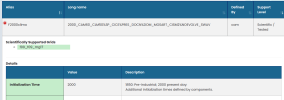Hi,all!
I look through the page and I want to know what's Initialization Time? For FHIST_BGC, the Initialization Time value is HIST. Does means the timeseries of inputdata is 1850-2000?
If I want to set the Initialization Time by my own, the parameter is "RUN_STARTDATE"? Where can i find the parctice example or guidance?I barely know the protocol for setting this.

The initialzation time of F2000climo is 2000. The value is fixed, it means I can't change the initialization time? like I change this value to 1850, What will happen?
If I set the initialzation time to 2000 in FHIST. Now,What's difference between F2000climo and FHIST?

I look through the page and I want to know what's Initialization Time? For FHIST_BGC, the Initialization Time value is HIST. Does means the timeseries of inputdata is 1850-2000?
If I want to set the Initialization Time by my own, the parameter is "RUN_STARTDATE"? Where can i find the parctice example or guidance?I barely know the protocol for setting this.

The initialzation time of F2000climo is 2000. The value is fixed, it means I can't change the initialization time? like I change this value to 1850, What will happen?
If I set the initialzation time to 2000 in FHIST. Now,What's difference between F2000climo and FHIST?

